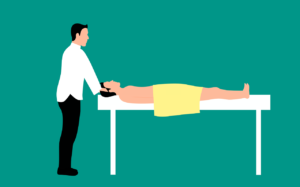
Imagine waking up in the morning, feeling refreshed and ready to take on the day. But as soon as you try to move your head, a sharp pain shoots through your neck, leaving you feeling discomforted and frustrated. We’ve all been there – an extremely sore neck after sleeping can be a real pain. Whether it’s due to a poor sleeping position or a stressful day, this article will provide you with simple yet effective tips on how to relieve that unbearable neck pain. Say goodbye to those sleepless nights and hello to a pain-free day ahead.

Causes of an Extremely Sore Neck
Poor sleeping posture
One of the main causes of an extremely sore neck after sleeping is poor sleeping posture. When you sleep in a position that does not adequately support your neck, it can lead to strain on the muscles, resulting in pain and discomfort. Sleeping with your head bent at an awkward angle or with your neck twisted can put unnecessary pressure on the cervical spine, leading to a sore neck.
Wrong pillow choice
Using the wrong pillow can also contribute to an extremely sore neck. Pillows that are too high or too flat can create an unnatural alignment of the neck and spine, causing discomfort during sleep. It is important to choose a pillow that properly supports the natural curve of your neck and keeps your head in a neutral position.
Mattress quality
The quality of your mattress can have a significant impact on your neck health. An old or worn-out mattress that lacks proper support can lead to poor spinal alignment and muscle strain. It is crucial to sleep on a mattress that provides adequate support for your body, particularly in the neck and spine area.
Neck muscle strain
Engaging in activities that strain the neck muscles, such as repetitive movements, poor posture during the day, or carrying heavy loads, can also contribute to an extremely sore neck after sleeping. When the neck muscles are already fatigued or strained, the pressure exerted on them during sleep can further aggravate the soreness.
Preventing Sore Neck from Occurring
Choosing the right pillow
To prevent a sore neck from occurring, it is important to choose a pillow that suits your specific needs. Consider the ideal thickness for your neck and head, as well as the materials used in the pillow. Memory foam and contour pillows are often recommended for providing optimal support and relieving pressure points.
Maintaining a good sleeping posture
Maintaining a good sleeping posture is crucial in preventing neck pain. Sleeping on your back with a pillow that supports the natural curve of your neck is often the best position for neck health. If you are a side sleeper, ensure that your pillow is thick enough to keep your neck aligned with your spine. Avoid sleeping on your stomach as it can strain your neck and lead to pain.
Using a supportive mattress
Investing in a supportive mattress can make a significant difference in preventing a sore neck. Look for a mattress that offers adequate support and has a medium-firm to firm level of comfort. This ensures that your body, including your neck and spine, is properly aligned while you sleep, reducing the likelihood of waking up with a sore neck.
Regular neck exercises
Engaging in regular neck exercises can help strengthen the muscles and prevent soreness. Simple exercises such as neck stretches, rotations, and head tilts can improve flexibility and reduce tension in the neck and shoulder area. Additionally, incorporating upper back and neck strengthening exercises into your routine can help prevent muscle strain.

Immediate Relief for an Extremely Sore Neck
Applying heat or cold therapy
Applying heat or cold therapy to the sore neck can provide immediate relief. A warm towel or heat pack can help relax the muscles and improve blood circulation, while an ice pack or cold compress can reduce inflammation and numb the area. Alternate between heat and cold therapy to find what works best for your neck pain.
Gentle stretching exercises
Gentle stretching exercises can help relieve tension and improve mobility in the neck. Neck flexion and extension stretches, side-to-side neck stretches, and shoulder and upper back stretches can all contribute to relieving a sore neck. Take your time with these stretches and avoid any movements that cause pain or discomfort.
Over-the-counter pain relievers
Over-the-counter pain relievers can help alleviate the pain and inflammation associated with a sore neck. Nonsteroidal anti-inflammatory drugs (NSAIDs), such as ibuprofen or naproxen, can provide temporary relief, but it is important to follow the recommended dosage and consult a healthcare professional if the pain persists or worsens.
Overnight neck support
Using overnight neck support, such as a neck pillow or a rolled towel, can help maintain proper alignment and provide support to the neck while you sleep. This extra support can alleviate pain and prevent further strain on the neck muscles, promoting a better night’s sleep and reducing soreness in the morning.
Long-Term Solutions for Sore Neck Prevention
Ergonomic sleeping setup
Creating an ergonomic sleeping setup is essential for long-term sore neck prevention. Ensure that your mattress, pillows, and sleeping positions are all aligned to promote optimal spinal alignment. Consider investing in ergonomic sleep products, such as adjustable pillows or mattress toppers, to customize your sleeping environment for improved neck health.
Regular neck stretches and exercises
Maintaining a regular routine of neck stretches and exercises can help prevent future episodes of a sore neck. Set aside a few minutes each day to perform gentle stretching exercises, focusing on the neck, shoulders, and upper back. This habit will help improve flexibility, strengthen the muscles, and reduce the likelihood of waking up with a sore neck.
Seeking professional advice
If you are frequently experiencing an extremely sore neck after sleeping or if the pain persists despite trying various remedies, it is advisable to seek professional advice. A healthcare professional, such as a physical therapist or chiropractor, can assess your condition, provide personalized recommendations, and guide you in managing and preventing future neck pain.
Maintaining good sleep hygiene
Maintaining good sleep hygiene practices can contribute to overall neck health. This includes having a consistent sleep schedule, creating a comfortable and conducive sleep environment, avoiding caffeine and electronic devices before bed, and practicing relaxation techniques to ensure better quality sleep. Adequate sleep and reduced stress can help prevent the occurrence of a sore neck.

Choosing the Right Pillow
Finding your ideal pillow thickness
To find your ideal pillow thickness, consider your sleeping position and personal comfort preferences. Back sleepers generally benefit from thinner pillows, while side sleepers may need thicker pillows to keep their neck properly aligned. Test different pillow thicknesses to determine the one that provides the best support for your neck.
Considering different pillow materials
There are various pillow materials available, each with its own advantages. Memory foam pillows conform to the shape of your head and neck, providing customized support. Latex pillows offer a good balance of support and comfort, while down pillows are soft and moldable. Experiment with different pillow materials to find the one that suits your preferences and neck support needs.
Supporting neck and head alignment
A crucial aspect of choosing the right pillow is ensuring proper neck and head alignment. Your pillow should fill the space between your neck and the mattress, keeping your head in a neutral position. Look for pillows with contours or neck support areas that help maintain this alignment, reducing the risk of waking up with a sore neck.
Testing different pillow shapes
Different pillow shapes can cater to different sleep preferences and support needs. Traditional pillows, which are rectangular in shape, are versatile and widely available. Contour or cervical pillows have a curved design that supports the natural curve of your neck. Wedge pillows can help elevate your upper body and relieve pressure. Experiment with different pillow shapes to find the one that offers the best support and comfort for your neck.
Maintaining a Good Sleeping Posture
Sleeping on your back
Sleeping on your back is often considered the best sleeping position for neck health. When you sleep on your back, your neck and spine are in a neutral position, minimizing strain on the muscles and reducing the chances of a sore neck. Use a pillow that supports the natural curve of your neck and keeps your head aligned with your spine.
Using a rolled towel for extra support
For additional support while sleeping on your back, place a rolled towel under your neck. This helps maintain the natural curve of the cervical spine and provides extra support. Ensure that the towel is not too thick or firm, as it may cause discomfort or strain the neck muscles.
Avoiding stomach sleeping
Sleeping on your stomach can strain your neck, as it forces your head to be turned to the side for an extended period. This can lead to a sore neck and discomfort upon waking up. If you are a stomach sleeper, try transitioning to a different sleeping position, such as sleeping on your side or back, to alleviate the strain on your neck muscles.
Pillow placement for side sleepers
For those who prefer sleeping on their side, proper pillow placement is crucial. Use a pillow that is thick enough to keep your neck aligned with your spine while on your side. Place the pillow between your neck and shoulder to provide additional support and prevent your head from tilting downward or to the side.
Using a Supportive Mattress
Understanding mattress firmness levels
Mattresses come in different firmness levels, ranging from soft to firm. Understanding the firmness levels can help you choose a mattress that provides adequate support for your neck. While personal preferences vary, a medium-firm to firm mattress is generally recommended for maintaining proper spinal alignment and reducing the risk of a sore neck.
Choosing the right mattress type
When selecting a mattress, consider different types such as memory foam, latex, or innerspring. Memory foam mattresses contour to your body’s curves, relieving pressure points and promoting proper alignment. Latex mattresses offer a responsive and supportive surface, while innerspring mattresses provide robust support and airflow. Test out different mattress types to determine which one offers the best support and comfort for your neck.
Using mattress toppers or pads
If your current mattress does not provide adequate support, consider using a mattress topper or pad to enhance its comfort and support levels. Memory foam or latex mattress toppers can add an extra layer of cushioning and support, relieving pressure on your neck and reducing the chances of experiencing a sore neck after sleeping.
Replacing old and worn-out mattresses
An old or worn-out mattress can greatly contribute to neck discomfort and pain. Over time, mattresses lose their ability to provide proper support and alignment, resulting in increased strain on the neck and spine. If your mattress is more than eight years old or has noticeable sagging, it may be time to consider replacing it with a new one that offers better support and comfort.
Regular Neck Exercises
Neck stretches and rotations
Performing gentle neck stretches and rotations can help relieve tension and improve flexibility in your neck muscles. Slowly tilt your head forward, backward, and side to side, holding each position for a few seconds. Rotate your head in a circular motion, both clockwise and counterclockwise. These exercises can help reduce muscle tightness and maintain a healthy range of motion in your neck.
Shoulder rolls and shrugs
Shoulder rolls and shrugs can help alleviate tension in the neck and upper back muscles. Roll your shoulders forward and backward in a circular motion, allowing the movement to extend to your neck. Shrug your shoulders up towards your ears and then relax them down. Repeat these exercises regularly to promote muscle relaxation and reduce soreness.
Chin tucks and head tilts
Chin tucks and head tilts are effective exercises for strengthening the muscles in your neck and upper back. To perform a chin tuck, gently pull your chin inward towards your chest, while keeping your back straight. Hold for a few seconds and then release. For head tilts, slowly tilt your head to one side, bringing your ear towards your shoulder. Repeat on the other side. These exercises can improve posture and reduce muscle strain.
Upper back and neck strengthening exercises
Engaging in upper back and neck strengthening exercises can help prevent muscle strain and promote better neck health. Exercises such as rowing motions with resistance bands, dumbbell shrugs, and gentle yoga poses like the Cobra pose can target the muscles that support the neck and upper back. Incorporate these exercises into your regular fitness routine to build strength and stability in the neck area.
Applying Heat or Cold Therapy
Using a warm towel or heat pack
Applying a warm towel or heat pack to your sore neck can help relax the muscles and increase blood flow to the area. The warmth helps soothe muscle tension and reduces inflammation, providing immediate relief. Wrap a warm towel around your neck or use a heat pack for around 15 minutes at a time. Make sure the temperature is comfortable and not too hot to avoid burns.
Taking a warm shower or bath
A warm shower or bath can also provide relief for an extremely sore neck. The warm water helps relax the muscles and promote blood circulation, easing tension and reducing discomfort. Stand under the shower with the warm water flowing over your neck and shoulders, or soak in a warm bath for 15-20 minutes to experience the benefits.
Applying an ice pack or cold compress
Cold therapy can be effective in reducing inflammation and numbing the area, providing temporary relief for a sore neck. Wrap an ice pack or a cold compress in a thin cloth and apply it to the affected area for about 15 minutes at a time. Be sure to avoid direct contact with the skin as it may cause ice burn.
Alternate heat and cold therapy
Some individuals find relief from alternating between heat and cold therapy for an extremely sore neck. Start with heat therapy, such as a warm towel or heat pack, for a few minutes, and then switch to cold therapy, such as an ice pack or cold compress, for a few minutes. Repeat this alternating process for several cycles, ending with cold therapy. This contrast therapy can help reduce inflammation and alleviate pain.
Gentle Stretching Exercises
Neck flexion and extension stretches
Neck flexion and extension stretches can help relieve tension and improve flexibility in the neck muscles. Gently tilt your head forward to bring your chin towards your chest, feeling the stretch in the back of your neck. Hold for a few seconds and then slowly bring your head back to a neutral position. To perform an extension stretch, slowly tilt your head back, looking up towards the ceiling. Hold for a few seconds and return to the neutral position. Repeat these stretches several times, taking it slowly and avoiding any sudden movements.
Side-to-side neck stretches
Side-to-side neck stretches target the muscles on the sides of your neck, helping to relieve tension and increase range of motion. To perform this stretch, slowly tilt your head towards one shoulder, bringing your ear closer to it. Hold for a few seconds and then return to the neutral position. Repeat on the other side. Be gentle with the stretch and avoid any painful or uncomfortable positions.
Shoulder and upper back stretches
Stretching the shoulders and upper back can also contribute to relieving a sore neck. Stand or sit upright and slowly roll your shoulders forward and backward in a circular motion. This movement helps release tension in the muscles surrounding the neck and upper back. Additionally, interlace your fingers behind your back and gently straighten your arms to stretch the chest and shoulders. Hold the stretch for a few seconds and then release.
Gentle yoga poses for neck relief
Certain gentle yoga poses can help alleviate neck pain and promote relaxation. The Child’s Pose, Cat-Cow stretch, and Supine Twist are a few examples. The Child’s Pose involves kneeling on the floor and sitting back on your heels, extending your arms forward and resting your forehead on the ground. The Cat-Cow stretch involves transitioning between an arched back and a rounded back position, gently moving the neck along with the spine. The Supine Twist involves lying on your back and gently twisting your lower body to one side, allowing your neck to follow the movement. These poses can help release tension and promote flexibility in the neck muscles.
In conclusion, an extremely sore neck after sleeping can be caused by various factors such as poor sleeping posture, the wrong pillow choice, mattress quality, and neck muscle strain. To prevent a sore neck, it is important to choose the right pillow, maintain a good sleeping posture, use a supportive mattress, and engage in regular neck exercises. When immediate relief is needed, applying heat or cold therapy, performing gentle stretching exercises, taking over-the-counter pain relievers, and using overnight neck support can all help alleviate pain. For long-term sore neck prevention, creating an ergonomic sleeping setup, incorporating regular neck stretches and exercises into your routine, seeking professional advice when needed, and maintaining good sleep hygiene are essential. By implementing these strategies, you can reduce the likelihood of waking up with an extremely sore neck and improve your overall neck health.







